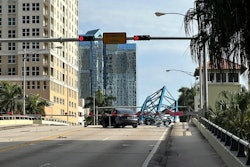
Despite construction industry association objections, a new rule will take effect May 31 that will allow union representatives to accompany federal safety inspectors on non-union employers’ jobsites.
The rule, issued by the U.S. Occupational Safety and Health Administration, is designed to clarify workers’ and employers’ rights to have representation during OSHA inspections on all jobsites, whether they are union or non-union. It says workers may authorize another employee to serve as their representative or select a non-employee third party. That third-party representative has been expanded to include a representative of a labor union, an attorney or someone else of the employee’s choosing.
Construction groups, however, view it as a backdoor way for unions to try to gain a foothold on non-union jobsites.
“By allowing outside union agents access to non-union employers’ private property, OSHA is injecting itself into labor-management disputes and casting doubt on its status as a neutral enforcer of the law,” says Greg Sizemore, Associated Builders and Contractors vice president of health, safety, environment and workforce development. “This final rule negatively impacts the rights of employers while simultaneously ignoring the rights of the majority of employees who have not authorized a union to represent them.”
OSHA argues that the rule will make jobsites safer and add expertise to the inspection process.
"Worker involvement in the inspection process is essential for thorough and effective inspections and making workplaces safer," says OSHA Assistant Secretary Doug Parker. "The Occupational Safety and Health Act gives employers and employees equal opportunity for choosing representation during the OSHA inspection process, and this rule returns us to the fair, balanced approach Congress intended."
Federal law currently allows employees to authorize a representative to accompany an OSHA inspector, such as a safety engineer or industrial hygienist. There must be “good cause” to choose the third party.
Along with expanding who the third party can be, the new rule authorizes the OSHA inspector to determine if the third party is “reasonably necessary to conduct an effective and thorough inspection.” The inspectors can also “prevent someone from participating in the walkaround inspection if their conduct interferes with a fair and orderly inspection, or to limit participation to protect employer trade secrets,” OSHA says.
Construction groups, however, argue that the rule unfairly makes OSHA inspectors the judge of who should belong on the inspection. The third parties could also be unfamiliar with jobsite safety and could even be at risk themselves for injury due to lack of knowledge, they say.
“This rule forces construction businesses to oblige third parties who do not possess safety expertise to disrupt a jobsite,” says Doug Carlson, CEO of the National Utility Contractors Association. “It puts neutral OSHA inspectors into very contentious labor disputes.”
He adds that the rule does not provide adequate guidance for the inspection process and that the NUCA supports legal action to reverse the rule.
The Associated General Contractors says it is considering a legal challenge to the rule. “While OSHA believes that there will be no change to the current inspection process, AGC believes that there are significant concerns that could arise from the agency’s new policy,” the association says. “Such concerns include the lack of a formal process for the identification of the representative among employees, lack of notification to employers as to whom this individual may be as well as an established process for employers to dispute the selection, and the limited ability for a compliance safety and health officer to verify the qualifications of the individual or individuals.”
Workers’ advocacy groups, like the National Council for Occupational Safety and Health, support the new rule because they say it will give workers a stronger voice in jobsite inspections and correcting hazards.
“With a trusted worker representative onsite, safety inspections can more effectively capture the firsthand knowledge workers have about work processes and potential hazards,” says Jessica E. Martinez, co-executive director of National COSH. “A representative selected by workers can also bridge language barriers and reduce the fear of retaliation, which is often a major barrier in gathering accurate information about workplace conditions.”
The final OSHA rule was published in the Federal Register on April 1 and takes effect May 31. To see the final published rule, click here.











